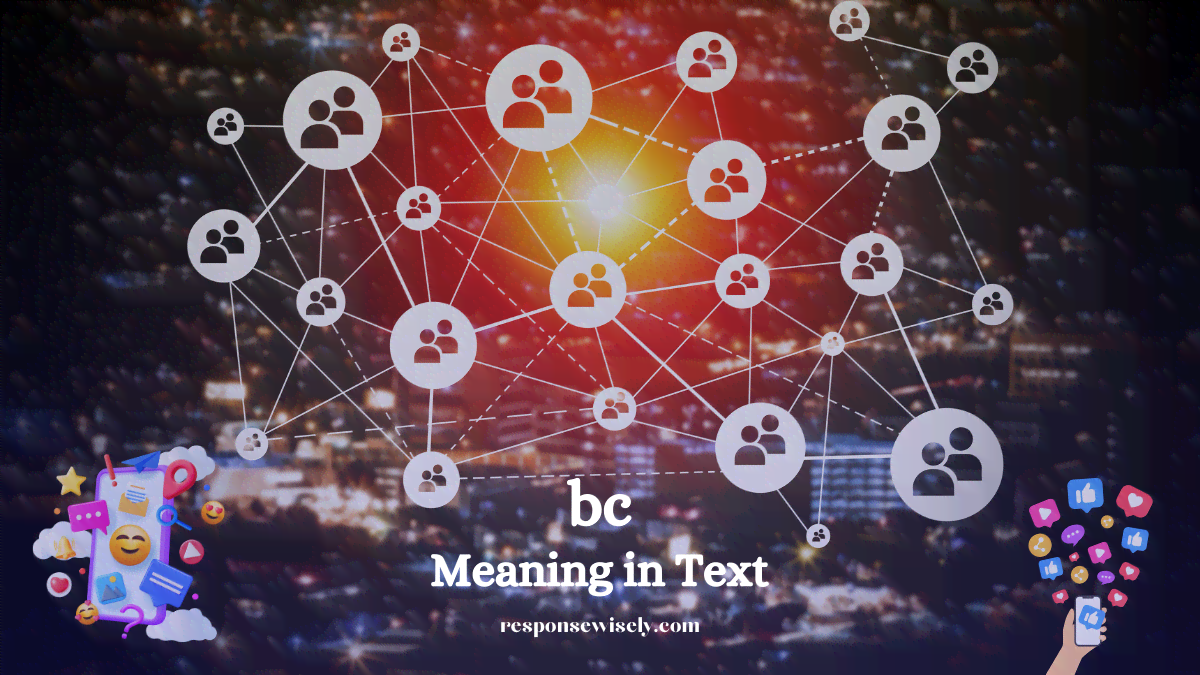In the ever-evolving world of digital communication, it’s easy to get lost in the sea of acronyms and shorthand. One such term that’s become increasingly popular is “bc”. But what does it mean in text, and how should you use it?
“bc” is a common abbreviation in text messaging, social media, and online chats. It’s a shortcut for the word “because”, helping to keep conversations brief and to the point. In the following paragraphs, I’ll dive deeper into the usage and nuances of this popular internet slang. So, whether you’re a seasoned texter or a newbie, stick around as we demystify “bc” for you.
Understanding the Meaning of “BC” in Text
As we journey further into this digital age, it’s crucial to keep up with the evolving language of online communication. And one such fascinating word shift comes in the form of abbreviated expressions like “bc”. The question then arises: what’s the meaning of “bc” in text?
Let’s decode this together.
Taking advantage of the speed and convenience of digital messaging, people often opt for brevity over formality. Here, “bc” stands as a condensed form of “because”. It’s a simple substitution of a single word that normally consists of seven characters down to two.
Typically, you’ll encounter “bc” in informal digital contexts such as online chats, social media posts, and text messages. An example would be “I wasn’t at school bc I was sick.” Here, the sender has replaced “because” with its shorter, quicker equivalent “bc”.
Just remember that while “bc” is a convenient shorthand, it’s not universally used or understood in more formal digital settings. It’s best to stick with the full word “because” in professional emails, academic writing, and other more formal types of communication.
Take note that “bc” isn’t case sensitive, so whether it’s written as “b/c”, “B/C”, or “bc”, they all essentially mean “because”. Each variant is interchangeable and doesn’t change the intended meaning in any way.
To illustrate this, let’s use another example. “I did it bc I wanted to.” This sentence could also be written as “I did it B/C I wanted to.” or “I did it b/c I wanted to”. All these sentences carry the same meaning. The choice largely depends on the writer’s preference and the context of the conversation.
Immersing yourself in the world of digital communication, it’s beneficial to stay updated with the evolving jargon and shorthand notations. That way, you’ll always be in the loop and able to communicate efficiently and effectively in today’s fast-paced digital world.
| Abbreviation | Meaning |
|---|---|
| bc | because |
| B/C | because |
| b/c | because |
The Origin and History of “BC”
With the rise of digital communication came the need for speed. This need propelled the shorthand culture where “bc”, among other abbreviations, found its way into texts and social media posts. But where did this handy shorthand stem from? It’s time we delve into that history, circling back to its ancient origins and its use in religious texts and calendars.
The Ancient Origins of “BC”
When we think of “bc” in its current context, unearthing an ancient origin for this digital shorthand might seem far-fetched. However, it’s worth noting that abbreviation as a practice has been integral to human communication for millennia. Scribes of old, dealing with time-consuming handwriting and limiting material resources, often truncated and condensed words in texts. From the Roman scribes’ use of “SPQR” (Senatus Populusque Romanus, translating to ‘The Senate and the People of Rome’), to an abbreviation like “lb”, a shortening of the Latin “libra”, which we still use today, abbreviations aren’t a novel concept.
“BC” in Religious Texts and Calendars
Interestingly, the term “BC” boasts significant historical and religious connotations. It’s widely used to denote the years preceding the birth of Jesus Christ in the Gregorian and Julian calendars. “BC”, in this context, stands for “Before Christ”. However, the use of “BC” in digital communication, as an abridged form of “because”, emerged from a completely different set-up. It evolved from the internet’s fast-paced chat rooms and message boards, where saving time and keystrokes was of the essence.
So you see, whether it’s a cultural or tech revolution, abbreviations have and will continue to be a critical part of our excursions into language and communication. Who knows what new abbreviations will become commonplace as we further venture into the digital age? Only time will tell. What’s certain, though, is the importance of keeping up-to-speed with these linguistic shifts in order to stay relevant and connected in our increasingly digital world.
Common Usage of “BC” Today
People’s dialects continuously adapt to the fast-paced change in communication channels. In this context, let’s explore the common usage of “BC” in today’s digital landscape.
“BC” in Historical and Academic Writing
“BC‚Äù isn‚Äôt typically found in historical or academic writing. These platforms usually demand a more formal vocabulary, and abbreviations like “BC” for “because” tend not to meet that standard. Despite this, there’s a prominent exception where “BC” takes an entirely different connotation: Before Christ, abbreviated as BC, is a time designation used to reference years that happened before the traditional birth year of Jesus Christ. Despite the widespread secularization of society, this usage of “BC” continues to endure.
“BC” in Informal Communication
On the other hand, the use of “BC” meaning “because” thrives in informal digital communication. You’ll often spot “BC” making appearances in online chats, social media feeds, and text messages. Here, users prize brevity and speed over formal composition. Whether you’re dashing off a quick tweet or typing a hurried text message, “BC” can save you precious seconds. It’s almost become the norm among those who’ve fully embraced Internet linguistics.
Admittedly, the use of “bc” does pose some potential for misunderstanding, especially for those who are not privy to such online jargon. However, the context often helps to decipher its intended meaning. Moreover, it’s crucial to keep pace with evolving linguistic nuances to stay relevant in a continuously changing digital landscape.
| Usage Context | Example |
|---|---|
| Historical and Academic Writing | ‘Alexander the Great died in 323 BC.’ |
| Informal Digital Communication | ‘@user: I‚Äôm late bc I missed the bus’ |
While we’ve moved away quite a bit from using “BC” to denote time in historical or academic writing, its incarnation as an abbreviation for “because” in digital communication seems stronger than ever, reflecting the dynamism and creativity that language allows. Yet, it’s essential to note that while its usage may be prevalent in informal contexts, “bc” is not universally accepted or understood. Until it attains more extensive acceptance, reserve it for your casual digital discourses.
Alternatives to “BC” in Modern Language
In the ever-evolving world of digital communication, “bc” is far from the only condensed word you’ll encounter. It’s crucial to stay informed about these shortcuts to ensure effective and clear conversations.
An integral aspect of understanding text language is knowing the alternatives or synonyms that work just as well. For instance, in lieu of “bc”, other phrases such as “cuz”, “cos”, and “coz” can serve the same purpose. They’re often seen in informal internet settings like chat rooms and quick messages.
In the realm of formal digital communication, it’s always recommended to stick to the full form “because”. It adds an air of professionalism and leaves no room for misunderstanding.
Then, there’s the classic “Before Christ” usage. “AD”, an abbreviation for “Anno Domini”, has been used traditionally. Nowadays, though, many academic and historical publications are moving towards “CE” (Common Era) and “BCE” (Before Common Era) in place of “AD” and “BC” respectively.
Regardless of the initialisms or abbreviations used, the ultimate objective should be clarity in conveying the intended message. That’s where keeping up with the ever-shifting landscape of digital linguistic is vital. It’s also essential to remember that the appropriateness of such abbreviations largely depends on the formality and context of the conversation.
In essence, the ability to use and understand abbreviations is an essential part of being digitally savvy. From “because” to “Before Christ”, being well-versed in the different uses of “bc” is part of this bigger journey. As the digital landscape continues to change, as does the language used within it, it’s key to stay ahead of the curve, with knowledge of synonyms and abbreviations in hand.
Conclusion: The Ever-Evolving Use of “BC” in Text
So, the world of digital communication is always changing and “bc” is just a small part of this evolution. It’s a handy shortcut for “because” and useful in informal settings. But remember, it’s not always understood or accepted in formal contexts. The variants “b/c” and “B/C” mean the same thing, and alternatives like “cuz”, “cos”, and “coz” are also out there. Then there’s “AD”, “CE”, and “BCE” for academic and historical use. It’s all about understanding your audience and choosing the right term. Staying informed about these linguistic shifts is crucial. After all, clear communication is key in our digital age. So keep adapting and keep learning. The language of text is a fascinating, ever-changing landscape.


